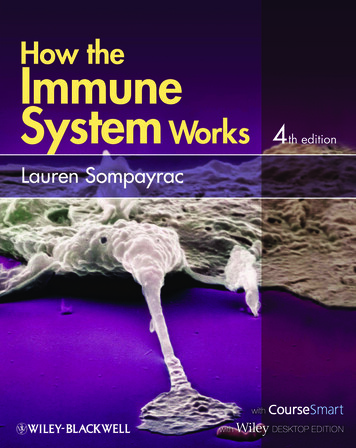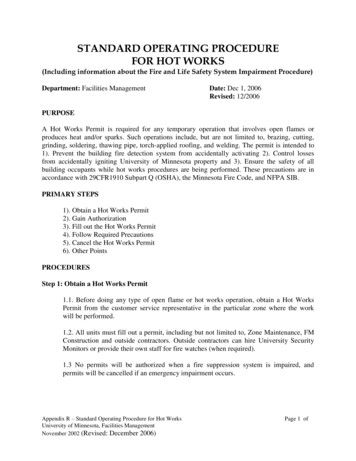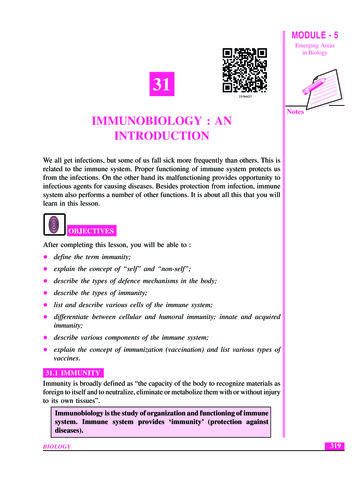
Transcription
How the ImmuneSystem Works
I dedicate this book to my sweetheart, my best friend,and my wife: Vicki Sompayrac.
How the ImmuneSystem WorksFOURTH EDITIONLauren Sompayrac, PhDA John Wiley & Sons, Ltd., Publication
This edition first published 2012 2012 by John Wiley & Sons, Ltd.Wiley-Blackwell is an imprint of John Wiley & Sons, formed by the merger of Wiley’sglobal Scientific, Technical and Medical business with Blackwell Publishing.Registered office: John Wiley & Sons, Ltd, The Atrium, Southern Gate, Chichester, WestSussex, PO19 8SQ, UKEditorial offices: 9600 Garsington Road, Oxford, OX4 2DQ, UKThe Atrium, Southern Gate, Chichester, West Sussex, PO19 8SQ, UK111 River Street, Hoboken, NJ 07030-5774, USAFor details of our global editorial offices, for customer services and for informationabout how to apply for permission to reuse the copyright material in this book pleasesee our website at www.wiley.com/wiley-blackwell.The right of the author to be identified as the author of this work has been asserted inaccordance with the UK Copyright, Designs and Patents Act 1988.All rights reserved. No part of this publication may be reproduced, stored in a retrievalsystem, or transmitted, in any form or by any means, electronic, mechanical,photocopying, recording or otherwise, except as permitted by the UK Copyright,Designs and Patents Act 1988, without the prior permission of the publisher.Designations used by companies to distinguish their products are often claimed astrademarks. All brand names and product names used in this book are trade names,service marks, trademarks or registered trademarks of their respective owners. Thepublisher is not associated with any product or vendor mentioned in this book. Thispublication is designed to provide accurate and authoritative information in regard tothe subject matter covered. It is sold on the understanding that the publisher is notengaged in rendering professional services. If professional advice or other expertassistance is required, the services of a competent professional should be sought.First published 1999Second edition 2003Third edition 2008Fourth edition 2012Cover image and Figure 1 used with permission from Lennart Nilsson photography /Boehringer Ingelheim / SCANPIX.Library of Congress Cataloging-in-Publication DataSompayrac, Lauren.How the immune system works / Lauren Sompayrac. – 4th ed.p. cm.Includes bibliographical references and index.ISBN 978-0-470-65729-4 (pbk. : alk. paper) 1. Immune system.2. Immunity. I. Title.[DNLM: 1. Immune System–physiology. 2. Immune System–anatomy & histology.3. Immune System–physiopathology. 4. Immunity–physiology. QW 504 S697h 2012]QR181.S65 2012616.07'9–dc232011024775A catalogue record for this book is available from the British Library.Set in 9.5/13 pt Palatino by Toppan Best-set Premedia Limited12012
ContentsAcknowledgments, viiHow to Use This Book, viiiThis book is neither a comprehensive text nor an exam-review tool. It is an overview of the immunesystem designed to give anyone who is learning immunology a feel for how the system all fitstogether.The Anytime, Anywhere Textbook, ixLECTURE 1An Overview, 1The immune system is a “team effort,” involving many different players who work together toprovide a powerful defense against invaders. Focusing in on one player at a time makes it hard tounderstand the game. Here we view the action from the grandstands to get a wide-angle picture ofwhat the immune system is all about.LECTURE 2The Innate Immune System, 13The innate immune system is a “hard-wired” defense that has evolved over millions of years torecognize pathogens that commonly infect humans. It provides a rapid and powerful defense against“everyday” invaders.LECTURE 3B Cells and Antibodies, 24B cells and the antibodies they produce are part of the adaptive immune system. This defense evolvesduring our own lifetime to protect us against invaders that we, personally, have never encounteredbefore.LECTURE 4The Magic of Antigen Presentation, 38T cells, another weapon of the adaptive immune system, only recognize invaders which are “properlypresented” by specialized antigen presenting cells. This feature keeps these important cells focusedon the particular attackers which they are able to defend against.LECTURE 5T Cell Activation, 52Before they can spring into action, T cells must be activated. This requirement helps ensure that onlyuseful weapons will be mobilized.LECTURE 6T Cells at Work, 60Once they have been activated, helper T cells orchestrate the immune response, and killer T cellsdestroy infected cells.v
viContentsL E C TURE 7Secondary Lymphoid Organs and Lymphocyte Trafficking, 70B and T lymphocytes travel through secondary lymphoid organs looking for the invaders they candefend against. Once activated, B and T cells are dispatched to those areas of the body in which theycan be most useful.L E C TURE 8Restraining the Immune System, 81The powerful weapons of the immune system must be restrained lest they become “overexuberant.”In addition, once an invader has been defeated, the immune system must be “reset” to prepare forfuture attacks.L E C TURE 9Tolerance Induction and MHC Restriction, 86T cells must be trained to focus on appropriately presented invaders, and B and T lymphocytes mustlearn not to attack our own bodies.L E C TURE 10 Immunological Memory, 96B and T cells remember invaders we have previously encountered, and respond much more quicklyand effectively to a subsequent attack by the same invader.L E C TURE 11 Vaccines, 102Vaccines are used to safely mimic the attack of an invader so that our immune system will be primedand ready for a real attack.L E C TURE 12 The Immune System Gone Wrong, 107The immune system generally does a good job of defending us while inflicting minimal “collateraldamage.” Sometimes, however, mistakes are made.L E C TURE 13 Immunodeficiency, 116Serious disease may result when our immune system does not operate at full strength.L E C TURE 14 Cancer and the Immune System, 121Because the immune system is set up to minimize the chance that its weapons will attack our ownbodies, it is not very good at defending us against cells that have become cancerous.L E C TURE 15 A Critique of the Immune System, 128The immune system has many strengths – and a few weaknesses.Glossary, 133Index, 136
AcknowledgmentsI would like to thank the following people, whose criticalcomments on the earlier editions were most helpful:Drs. Mark Dubin, Linda Clayton, Dan Tenen, Jim Cook,Tom Mitchell, Lanny Rosenwasser, and Eric Martz.Thanks also go to Diane Lorenz, who illustrated the firstand second editions, and whose wonderful artwork canstill be found in this book. Finally, I wish to thank VickiSompayrac, whose wise suggestions helped make thisbook more readable, and whose editing was invaluablein preparing the final manuscript.vii
How to Use This BookI wrote How the Immune System Works because I couldn’tfind a book that would give my students an overall viewof the immune system. Sure, there are as many good,thick textbooks as a person might have money to buy, butthese are crammed with every possible detail. There arealso lots of “review books” that are great if you want asummary of what you’ve already learned – but theywon’t teach you immunology. What was missing wasa short book that tells, in simple language, how theimmune system fits together – a book that presents thebig picture of the immune system, without the jargon andthe details.How the Immune System Works is written in the form of“lectures,” because I want to talk to you directly, just asif we were together in a classroom. Although Lecture 1 isa light-hearted overview, meant to give you a runningstart at the subject, you’ll soon discover that this is not“baby immunology.” How the Immune System Works is aconcept-driven analysis of how the immune systemplayers work together to protect us from disease – andwhy they do it this way.In Lectures 2 through 10, I focus more closely on theindividual players and their roles. These lectures areshort, so you probably can read them all in a couple ofafternoons. In fact, I strongly suggest that you begin byreading quickly through Lectures 1–10. The whole ideais to get an overall view of the subject, and if you readone lecture a week, that won’t happen. Don’t “study”these ten lectures your first time through. Don’t evenviiibother with the Thought Questions at the end of eachlecture. Just rip through them. Then, once you have a“feel” for the system, go back and spend a bit more timewith these same ten lectures to get a clearer understanding of the “hows and whys.”In Lectures 11–14, I discuss the AIDS virus, vaccines,allergies, autoimmune diseases, and cancer. These lectures will let you “practice” what you have learned in theearlier lectures by examining real-world examples of theimmune system at work. And Lecture 15 – A Critique ofthe Immune System – will help you put in full perspectivejust how wonderful the immune defense really is. So afteryou have gone through Lectures 1–10 twice, I’d suggestyou read these last five lectures. When you do, I thinkyou’ll be amazed by how much you now understandabout the immune system.In some settings, How the Immune System Works willserve as the main text for the immunology section of alarger course. For a semester-long undergraduate orgraduate immunology course, your professor may usethis book as a companion to a comprehensive textbook.In this situation, reviewing the appropriate lecture in Howthe Immune System Works as your course proceeds willhelp you keep the big picture in focus as the details arefilled in. It’s really easy to get lost in the details.No matter how your professor may choose to use thisbook, you should keep one important point in mind: Ididn’t write How the Immune System Works for your professor. This book is for you!
The Anytime, AnywhereTextbookFor the first time, your textbook comes with free access to a Wiley Desktop Edition – a digital, interactive version ofthis textbook which you own as soon as you download it.Your Wiley Desktop Edition allows you to:Search: Save time by finding terms and topics instantly in your book, your notes, even your whole library (once you’vedownloaded more textbooks)Note and Highlight: Colour code, highlight and make digital notes right in the text so you can find them quickly andeasilyOrganize: Keep books, notes and class materials organized in folders inside the applicationShare: Exchange notes and highlights with friends, classmates and study groupsUpgrade: Your textbook can be transferred when you need to change or upgrade computersTo access your Wiley Desktop Edition, find the redemption code on the inside front cover of this book and carefullyscratch away the top coating of the label. Visit www.vitalsource.com/software/bookshelf/downloads to download theBookshelf application to your computer, laptop or mobile device. Open the Bookshelf application on your computerand register for an account. Follow the registration process and enter your redemption code to download your digitalbook.CourseSmart gives your students instant access (via computer or mobile device) to this Wiley-Blackwell eTextbookand its extra electronic functionality, at 40% off the recommended retail print price. See all the benefits at www.coursesmart.com/students.It also offers you an immediate, efficient, and environmentally-friendly way to review this textbook for your course.For more information visit www.coursesmart.com/instructors.With CourseSmart, you can create lecture notes quickly with copy and paste, and share pages and notes with yourstudents. Access your Wiley CourseSmart digital textbook from your computer or mobile device instantly for evaluation, class preparation, and as a teaching tool in the classroom.Simply sign in at http://instructors.coursesmart.com/bookshelf to download your Bookshelf and get started. Torequest your desk copy, hit ‘Request Online Copy’ on your search results or book product page.ix
LECTURE 1An OverviewImmunology is a difficult subject to study for severalreasons. First, there are lots of details, and sometimesthese details get in the way of understanding the concepts. To get around this problem, we’re going to concentrate on the big picture. It will be easy for you to find thedetails somewhere else. A second difficulty in learningimmunology is that there is an exception to every rule.Immunologists love these exceptions, because they giveclues as to how the immune system functions. But fornow, we’re just going to learn the rules. Oh, sure, we’llcome upon exceptions from time to time, but we won’tdwell on them. Our goal is to examine the immunesystem, stripped to its essence. The third difficulty instudying immunology is that our knowledge of theimmune system is still evolving. As you’ll see, there aremany unanswered questions, and some of the things thatseem true today will be proven false tomorrow. I’ll try togive you a feeling for the way things stand now, and fromtime to time I’ll discuss what immunologists speculatemay be true. But keep in mind that although I’ll try to bestraight with you, some of the things I’ll tell you willchange in the future (maybe even by the time you readthis!).I think the main reason immunology is such a toughsubject, however, is that the immune system is a “teameffort” that involves many different players interactingwith each other. Imagine you’re watching a football gameon TV, and the camera is isolated on one player, say, thetight end. You see him run at full speed down the field,and then stop. It doesn’t seem to make any sense. Later,however, you see the same play on the big screen, andnow you understand: that tight end took two defenderswith him down the field, leaving the running back uncovered to catch the pass and run for a touchdown. Theimmune system is just like a football team. It’s a networkof players who cooperate to get things done, and justlooking at one player doesn’t make much sense. You needan overall view. That’s the purpose of this first lecture,which you might call “turbo immunology.” Here, I’mgoing to take you on a quick tour of the immune system,so you can get a feeling for how it all fits together. Thenin the next lectures, we’ll go back and take a closer lookat the players and their interactions.PHYSICAL BARRIERSOur first line of defense against invaders consists ofphysical barriers, and to cause real trouble, viruses, bacteria, parasites, and fungi must first penetrate theseshields. Although we tend to think of our skin as themain barrier, the area covered by our skin is only abouttwo square meters. In contrast, the area covered by themucous membranes that line our digestive, respiratory,and reproductive tracts measures about 400 square meters– an area about as big as two tennis courts. The mainpoint here is that there is a large perimeter which mustbe defended.T H E I N N AT E I M M U N E S Y S T E MAny invader that breaches the physical barrier of skin ormucosa is greeted by the innate immune system – oursecond line of defense. Immunologists call this system“innate” because it is a defense that all animals just naturally seem to have. Indeed, some of the weapons of theinnate immune system have been around for more than500 million years. Let me give you an example of howthis amazing innate system works.Imagine you are getting out of your hot tub, and as youstep onto the deck, you get a large splinter in your bigHow the Immune System Works, Fourth Edition. Lauren Sompayrac. 2012 John Wiley & Sons, Ltd. Published 2012 by John Wiley & Sons, Ltd.1
2 LECTURE 1 An Overviewtoe. On that splinter are many bacteria, and within a fewhours you’ll notice (unless you had a lot to drink in thathot tub!) that the area around where the splinter enteredis red and swollen. These are indications that your innateimmune system has kicked in. In your tissues are rovingbands of white blood cells that defend you against attack.To us, tissue looks pretty solid, but that’s because we’reso big. To a cell, tissue looks somewhat like a sponge withholes through which individual cells can move ratherfreely. One of the defender cells that is stationed in yourtissues is the most famous innate immune system playerof them all: the macrophage. If you are a bacterium, amacrophage is the last cell you want to see after your rideon that splinter. Here is an electron micrograph showinga macrophage about to devour a bacterium:released inside it. That’s why they are kept in pouches.Using this clever strategy, the macrophage can destroy aninvader without “shooting itself in the foot.” This wholeprocess is called phagocytosis, and this series of snapshots shows how it happens:Bacterium Outsideof MacrophageSurface ofMacrophagea)b)c)d)You will notice that this macrophage isn’t just waitinguntil it bumps into the bacterium, purely by chance. No,this macrophage actually has sensed the presence of thebacterium, and is reaching out a “foot” to grab it. But howdoes a macrophage know that a bacterium is out there?The answer is that macrophages have antennae (receptors) on their surfaces which are tuned to recognize“danger molecules” characteristic of common microbialinvaders. For example, the walls that surround bacteriaare made up of fats and carbohydrates that normally arenot found in the human body. These foreign moleculesrepresent “find me and eat me” signals for macrophages.Indeed, when macrophages detect danger molecules,they begin to crawl toward the microbe which is emittingthe foreign molecule.When it encounters a bacterium, a macrophage firstengulfs it in a pouch (vesicle) called a phagosome. Thisvesicle is then taken inside the macrophage, where itfuses with another vesicle termed a lysosome. Lysosomescontain powerful chemicals and enzymes which candestroy bacteria. In fact, these agents are so destructivethat they would kill the macrophage itself if they werePhagosomeLysosomefuse"so long,bacterium!"Macrophages have been around for a very long time.In fact, the ingestion technique macrophages employ issimply a refinement of the strategy that amoebas use tofeed themselves – and amoebas have roamed the earthfor about 2.5 billion years. Why is this creature called amacrophage, you may be wondering. “Macro,” of course,means large – and a macrophage is a large cell. Phagecomes from a Greek word meaning “to eat.” So a macrophage is a big eater. In fact, in addition to defendingagainst invaders, the macrophage functions as a garbagecollector. It will eat almost anything. Immunologists takeadvantage of this appetite by feeding macrophages ironfilings. Then, using a small magnet, they can separatemacrophages from other cells in a cell mixture. Really!Where do macrophages come from? Macrophages andall the other blood cells in your body are made in the bonemarrow, where they descend from self-renewing cellscalled stem cells – the cells from which all the bloodcells “stem.” By self-renewing, I mean that when a stemcell grows and divides into two daughter cells, it does a“one for me, one for you” thing in which some of thedaughter cells go back to being stem cells, and some ofthe daughters go on to become mature blood cells. Thisstrategy of continuous self-renewal insures that there willalways be blood stem cells in reserve to carry on theprocess of making mature blood cells.As each daughter cell matures, it has to make choicesthat determine which type of blood cell it will be when it
L E C T U R E 1 An Overviewgrows up. As you can imagine, these choices are notrandom, but are carefully controlled to make sure youhave enough of each kind of blood cell. For example,some daughter cells become red blood cells, whichcapture oxygen in the lungs, and transport it to all partsof the body. Indeed, our stem cell “factories” must turnout more than two million new red blood cells eachsecond to replace those lost due to normal wear and tear.Other descendants of a stem cell may become macrophages, neutrophils, or other types of “white” blood cells.Just as white wine really isn’t white, these cells aren’twhite either. They are colorless, but biologists use theterm “white” just to indicate that they lack hemoglobin,and therefore are not red. Here is a figure showing someof the many different kinds of blood cells a stem cell canbecome:B cellHelper T cellKiller T cellNK Cell"onemfor e""one for you"Self-renewingStem CellBi-potentialCellDendritic CellMacrophageNeutrophilEosinophilMast CellMegakaryocyteRed Blood Cell(Erythrocyte)When the cells which will mature into macrophagesfirst exit the bone marrow and enter the blood stream,they are called monocytes. All in all you have about twobillion of these cells circulating in your blood at any onetime. This may seem a little creepy, but you can be veryglad they are there. Without them, you’d be in deeptrouble. Monocytes remain in the blood for an average ofabout three days. During this time they travel to the capillaries, which represent the “end of the line” as far asblood vessels go, looking for a crack between the endothelial cells that line the capillaries. These cells are shaped3like shingles, and by sticking a foot between them, amonocyte can leave the blood, enter the tissues, andmature into a macrophage. Once in the tissues, most macrophages just hang out, do their garbage collecting thing,and wait for you to get that splinter so they can do somereal work.When macrophages eat the bacteria on that splinter inyour foot, they give off chemicals which increase the flowof blood to the vicinity of the wound. The build-up ofblood in this area is what makes your toe red. Some ofthese chemicals also cause the cells that line the bloodvessels to contract, leaving spaces between them so thatfluid from the capillaries can leak out into the tissues. Itis this fluid which causes the swelling. In addition, chemicals released by macrophages can stimulate nerves in thetissues that surround the splinter, sending pain signals toyour brain to alert you that something isn’t quite right inthe area of your big toe.During their battle with bacteria, macrophages alsoproduce and give off (secrete) proteins called cytokines.These are hormone-like messengers which facilitate communication between cells of the immune system. Some ofthe cytokines alert monocytes and other immune systemcells traveling in nearby capillaries that the battle is on,and influence these cells to exit the blood to help fight therapidly multiplying bacteria. And pretty soon, you havea vigorous “inflammatory” response going on in your toe,as the innate immune system battles to eliminate theinvaders.When you think about it, this is a great strategy. Youhave a large perimeter to defend, so you station sentinels(macrophages) to check for invaders. When these sentinels encounter the enemy, they send out signals (cytokines)that recruit more defenders to the site of the battle. Themacrophages then do their best to hold off the invadersuntil reinforcements arrive. Because the innate responseinvolves warriors like macrophages, which are programed to recognize many of the most common invaders,your innate immune system usually responds so quicklythat the battle is over in just a few days.There are other players on the innate team. For example,in addition to the “professional phagocytes” like macrophages, which make it their business to eat invaders, theinnate system also includes the complement proteins thatcan punch holes in bacteria, and natural killer (NK) cellswhich are able to destroy bacteria, parasites, virusinfected cells, and some cancer cells. We will talk moreabout the macrophage’s innate system teammates in thenext lecture.
4 LECTURE 1 An OverviewT H E ADAPTIVE IMMUNE SYSTEMAbout 99% of all animals get along just fine with onlynatural barriers and the innate immune system to defendthem. However, for vertebrates like us, Mother Naturelaid on a third level of defense: the adaptive immunesystem. This is a defense system that actually can adaptto protect us against almost any invader. It is most likelythat the adaptive immune system was designed to protectus and the other vertebrates against viruses, because, asyou will see, the innate immune system is not terriblyeffective against viruses.One of the first clues that the adaptive immune systemexisted came back in the 1790s when Edward Jennerbegan vaccinating the English against smallpox virus.In those days, smallpox was a major health problem.Hundreds of thousands of people died from this disease,and many more were horribly disfigured. What Jennerobserved was that milkmaids frequently contracted adisease called cowpox which caused lesions on theirhands that looked similar to the sores caused by thesmallpox virus. Jenner also noted that milkmaids whohad had cowpox almost never got smallpox (which, itturns out, is caused by a close relative of the cowpoxvirus).So Jenner decided to conduct a daring experiment. Hecollected pus from the sores of a milkmaid who hadcowpox, and used this to inoculate a little boy namedJames Phipps. Later, when Phipps was re-inoculated withpus from the sores of a person infected with smallpox, hedid not contract that disease. In Latin, the word for cowis vacca – which explains where we get the word vaccine.History makes out the hero in this affair to be EdwardJenner, but I think the real hero that day was the youngboy. Imagine having this big man approach you with alarge needle and a tube full of pus! Although this isn’t thesort of thing that could be done today, we can be thankfulthat Jenner’s experiment was a success, because it pavedthe way for vaccinations that have saved countless lives.Smallpox virus was not something humans encountered regularly. So Jenner’s experiment showed that if thehuman immune system were given time to prepare, itcould produce weapons that could provide protectionagainst an invader which it never had seen before.Importantly, the smallpox vaccination only protectedagainst smallpox or closely related viruses like cowpox.Phipps was still able to get mumps, measles, and the rest.This is one of the hallmarks of the adaptive immunesystem: It adapts to defend against specific invaders.Antibodies and B cellsEventually, immunologists determined that immunity tosmallpox was conferred by special proteins that circulated in the blood of immunized individuals. These proteins were named antibodies, and the agent that causedthe antibodies to be made was called an antigen – in thiscase, the cowpox virus. Here’s a sketch that shows theprototype antibody, immunoglobulin G (IgG):LIGHTCHAINANTIGEN BINDINGREGION (Fab)LIGHTCHAINSSS SS SSSFc REGIONHEAVY CHAINSAs you can see, an IgG antibody molecule is made upof two pairs of two different proteins, the heavy chain(Hc) and the light chain (Lc). Because of this structure,each molecule has two identical “hands” (Fab regions)that can bind to antigens. Proteins are the ideal moleculesto use for constructing antibodies that can grasp attackers, because different proteins can fold up into a myriadof complex shapes.IgG makes up about 75% of the antibodies in the blood,but there are four other classes of antibodies: IgA, IgD,IgE, and IgM. All of these antibodies are produced by “Bcells” – white blood cells that are born in the bone marrow,and which can mature to become antibody factories calledplasma B cells.In addition to having hands that can bind to an antigen,an antibody molecule also has a constant region (Fc)“tail” which can bind to receptors (Fc receptors) on thesurface of cells like macrophages. In fact, it is the specialstructure of the antibody Fc region that determines itsclass (e.g., IgG vs. IgA), which immune system cells it willbind to, and how it will function.The hands of each antibody bind to a specific antigen(e.g., a protein on the surface of the smallpox virus), so inorder to have antibodies available that can bind to manydifferent antigens, many different antibody molecules arerequired. Now, if we want antibodies to protect us fromevery possible invader (and we do!), how many differentantibodies would we need? Well, immunologists havemade rough estimates that about 100 million should do
L E C T U R E 1 An Overviewthe trick. Since each antigen binding region of an antibody is composed of a heavy chain and a light chain, wecould mix and match about 10 000 different heavy chainsand 10 000 different light chains to get the 100 milliondifferent antibodies we need. However, human cells onlyhave about 25 000 genes in all, so if each heavy or lightchain protein were encoded by a different gene, most ofthe B cell’s genetic information would be used up just tomake antibodies. You see the problem.IMMATUREB CELL DNAV1 V2 V3 40 25The riddle of how B cells could produce the 100 milliondifferent antibodies required to protect us was solved in1977 by Susumu Tonegawa, who received the Nobel Prizefor his discovery. When Tonegawa started working onthis problem, the dogma was that the DNA in every cellin the body was the same. This made perfect sense,because after an egg is fertilized, the DNA in the egg iscopied. These copies are then passed down to the daughter cells, where they are copied again, and passed downto their daughters, and so on. Therefore, barring errors incopying, each of our cells should end up with the sameDNA as the original, fertilized egg. Tonegawa, however,hypothesized that although this is probably true ingeneral, there might be exceptions. His idea was that allof our B cells might start out with the same DNA, but thatas these cells mature, the DNA that makes up the antibody genes might change – and these changes might beenough to generate the 100 million different antibodieswe need.Tonegawa decided to test this hypothesis by comparingthe DNA sequence of the light chain from a mature Bcell with the DNA sequence of the light chain froman immature B cell. Sure enough, he found that theywere different, and that they were different in a veryint
won’t teach you immunology. What was missing was a short book that tells, in simple language, how the immune system fits together – a book that presents the big picture of the immune system, without the jargon and the detai










